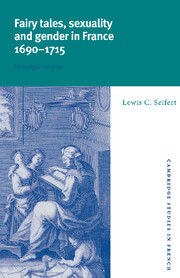Book contents
- Front Matter
- Contents
- Acknowledgments
- Note on translations and quotations
- Introduction
- Part I MARVELOUS STORYTELLING
- Part II MARVELOUS DESIRES
- Chapter 4 Quests for love: visions of sexuality
- Chapter 5 (De)mystifications of masculinity: fictions of transcendence
- Chapter 6 Imagining femininity: binarity and beyond
- Afterword
- Notes
- Selected bibliography
- Index
- Cambridge Studies in French
Chapter 4 - Quests for love: visions of sexuality
Published online by Cambridge University Press: 22 September 2009
- Front Matter
- Contents
- Acknowledgments
- Note on translations and quotations
- Introduction
- Part I MARVELOUS STORYTELLING
- Part II MARVELOUS DESIRES
- Chapter 4 Quests for love: visions of sexuality
- Chapter 5 (De)mystifications of masculinity: fictions of transcendence
- Chapter 6 Imagining femininity: binarity and beyond
- Afterword
- Notes
- Selected bibliography
- Index
- Cambridge Studies in French
Summary
One would be hard pressed to think of more stereotypical representations of love than fairy tales. Common motifs such as love at first sight, its power to conquer all obstacles, and marriage as “happiness ever after” are central features of our culture's most popular fairy tales. These motifs are also, of course, among the most abiding myths of Western romantic love. Why is it, then, that these myths have become so closely linked with the fairy-tale genre in our popular imagination? To begin to answer this question, we might consider colloquial expressions such as “fairy-tale romance” and “fairy-tale marriage”. As a non-ironic adjective, the word “fairy-tale” in these expressions recognizes a romantic ideal and, simultaneously, the near impossibility of its realization. The logic of these expressions would seem to hold that fairy tales are imaginary, unbelievable narratives, but that they also embody a fundamental truth to which everyone should aspire. Our culture seems convinced that the love portrayed in fairy tales is only rarely encountered in real life, but that “true” love is not fundamentally different from what stories like “Cinderella” or “Sleeping Beauty” tell us it is.
What precisely is the “truth” about love that so many fairy tales seem to represent? It is that heterosexual love, in its ideal form, presupposes the mutual satisfaction of masculine and feminine desires.
- Type
- Chapter
- Information
- Fairy Tales, Sexuality, and Gender in France, 1690–1715Nostalgic Utopias, pp. 101 - 137Publisher: Cambridge University PressPrint publication year: 1996

